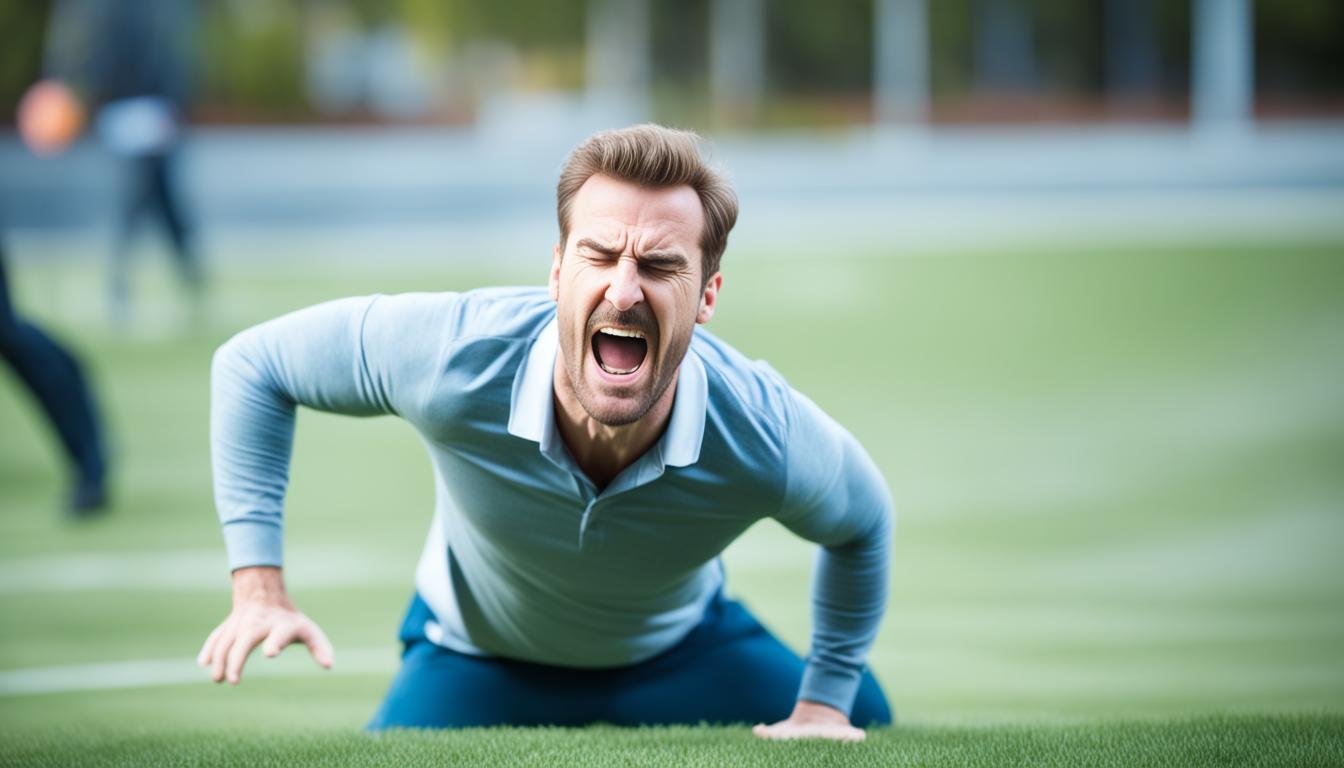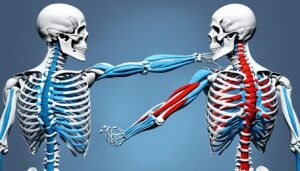Are you finding bending over causes lower back pain? You’re not alone. Many things can lead to this discomfort. Muscle strain, herniated discs, and others like sciatica, spondylolysis, and arthritis can be to blame. We’re here to discuss what might cause this pain, the symptoms, treatments, and how to stop it before it starts.
Key Takeaways
- Lower back pain when bending over is a prevalent issue, affecting nearly 40% of adult Americans.
- Bending over increases pressure on the lower back, which can worsen existing conditions or lead to new ones.
- Common causes include muscle strain, herniated discs, sciatica, spondylolysis, spondylolisthesis, and various forms of arthritis.
- Proper bending and lifting techniques, as well as self-care measures, can help manage and prevent lower back pain.
- Seeking medical attention is recommended if the pain worsens or persists despite self-care efforts.
Understanding Lower Back Pain When Bending Over
Nearly 40% of adult Americans have some back pain. Bending over puts more pressure on the lower back. It can make symptoms worse or start new ones. When you bend, the spine, muscles, and discs move. This makes the lower back more likely to get hurt and be in pain.
Prevalence of Back Pain
Up to 80% of adults face lower back pain when bending over during their lives. This pain is a top cause of disability all over the world. The lower back has five lumbar vertebrae (L1-L5) on top of each other. If these are off balance, it can cause more injuries and pain when bending over.
Increased Pressure on the Lower Back
The act of bending over adds a lot of pressure on the lower back. The spine, muscles, and discs all work during this motion. Things like not moving much, being too heavy, and health issues like arthritis can make the pain worse. It’s key to know how common this is and what leads to it. This helps find ways to stop and treat the pain.
Causes of Lower Back Pain When Bending
Lower back pain can happen when you hurt your spine’s muscles or ligaments. This back muscle injury makes you stiff, with muscle spasms, and hard to hold yourself up. It also makes moving tough.
Back Muscle Injury
This hurt in your lower back can be from workouts or not stretching enough. It comes from a sudden stretch or lifting something heavy or twisting. It makes the spot sore, especially when you bend down.
Other Symptoms of Muscle Injury
Not just pain, but a back muscle injury can bring on muscle spasms and make it hard to stand straight. You might find it tough to bend or reach for things, making normal tasks hard.
Treatments for Muscle Injury
Taking it easy, using anti-inflammatory drugs, and getting a massage helps this injury. Doing special exercises to make your back stronger and stretchy is good too. Sometimes, wearing a support on your back can also help you heal.
Herniated Disc
A herniated or “slipped” disc happens when the soft part inside a disc comes out. It puts pressure on nearby nerves. This happens more in younger and middle-aged adults.
Sudden force on the spine, like a fall or heavy lifting, can cause it. So can years of small injuries wearing the disc down.
Other Symptoms of Herniated Disc
Herniated discs can make your leg hurt, feel numb, or tingle. You might also feel weak or lose some reflexes. This is because the disc pushes on nerves.
Between 60 and 80% of people get low back pain sometime. Men aged 20 to 50 are more likely to get a herniated disc.
Treatments for Herniated Disc
Most herniated discs don’t need surgery. Treatments like rest, pain meds, or steroid injections often work. These injections help about half of the time.
If surgery is needed, a doctor would remove the part of the disc that’s causing trouble. But this is rare, mostly for severe cases. Some signs include not being able to move well or problems controlling your bladder or bowels.
Sciatica
Sciatica happens when a herniated disc presses on the sciatic nerve. It’s a main nerve in our body. This can cause sharp pain, numbness, and make your leg move less. Up to 85% of Americans can get back pain in their life. But not all back pain is from the sciatic nerve.
Other Symptoms of Sciatica
You might feel weak, tingling, or burning if you have sciatica. All these feelings go from the lower back down the buttock to the leg. Sitting or standing a lot can make the pain worse. Coughing, sneezing, or moving fast can hurt more.
Treatments for Sciatica
Good news, most sciatica cases get better without surgery. Things like anti-inflammatory pills, therapy, and hot/cold packs can help. If you have serious or lasting sciatica, you might need shots or surgery.
Learning about what causes and the signs of sciatica helps. You and your doctor can make a plan to treat and manage this tough condition.
Spondylolysis and Spondylolisthesis
Lower back pain often relates to spondylolysis and spondylolisthesis. Spondylolysis is a spinal vertebra stress fracture. Spondylolisthesis happens when a vertebra slips forward. They cause pain, posture problems, and discomfort in buttocks and thighs.
Other Symptoms of Spondylolysis
Those with spondylolysis may feel pain when bending over. You might also notice a stiff lower back, muscle spasms, and less movement. The pain is mostly where it’s injured but can spread down to the legs.
Treatments for Spondylolysis
Doctors might start by suggesting rest and using anti-inflammatory drugs. They could advise physical therapy too. Bracing helps support the spine. Surgery is a last resort if these steps don’t help enough.
Remember, not everyone feels symptoms from these conditions. Going for regular check-ups is smart. This way, a doctor can watch your condition and give advice if needed.
Arthritis and Lower Back Pain When Bending Over
Arthritis can make lower back pain worse, especially when you bend over. Different types of arthritis can hurt your spine. This includes osteoarthritis, rheumatoid arthritis, and ankylosing spondylitis.
Types of Arthritis Affecting the Back
Osteoarthritis is the main kind and it comes when the cartilage wears away. This causes bones to rub together and hurt. Rheumatoid arthritis happens when your immune system attacks your joints. Ankylosing spondylitis makes your spine stiff and limits how you can move.
Other Symptoms of Arthritis
Besides back pain, arthritis can make bending hard in other ways. It might make you stiff, limit your motion, and mess up how you stand. The pain and issues can get worse after you move a lot or if you sit still for too long.
Treatments for Arthritis
Treating arthritis back pain often starts with drugs that reduce swelling and physical therapy. For more serious cases, you might need to take other drugs. In some cases, you might even need surgery to fix or replace damaged joints.
Safe Bending and Lifting Techniques
Using the correct safe bending technique and safe lifting technique is key. It helps lessening the strain on your back. Remember to bend at your knees and hips, not just the waist. Don’t twist your body, and keep your feet far apart for balance. Always carry things near your waist to share the weight evenly.
Carts or dollies make moving heavy things easier and safer. It’s very important to know what you can lift safely. If you might lift too much, stretch first to get your body ready.
Talking to your bosses about work safety can make a big difference. They might offer training on how to lift the right way, change work areas, or give you tools to move things. This makes jobs with heavy things to lift safer.
Make using the right safe bending technique and safe lifting technique a part of your day. This helps keep your back healthy and safe. It’s worth it to learn how to move right to protect your back.
Self-Care Measures for Lower Back Pain When Bending Over
Bending and lifting techniques are important. Also, you can try some self-care measures for lower back pain when bending over. Here are some that may help:
- Take over-the-counter non-steroidal anti-inflammatory drugs (NSAIDs). Things like ibuprofen or acetaminophen can help reduce inflammation and pain.
- Apply ice and heat to your lower back. Switch between the two to calm muscle spasms and reduce soreness.
- Rest your back for a few days. Then, start gentle stretching exercises to improve movement slowly.
- Do low-impact physical activities such as walking. They can boost blood flow and help your back heal.
- Think about using a supportive back brace or another supportive device. These can offer extra help and comfort.
Trying these self-care lower back pain tips can help a lot. They might give you relief from back pain home treatments when bending over. You might not need to see a doctor right away.
When to Seek Medical Attention
If your back pain gets worse or stays bad after two weeks, see a doctor. Also, if you lose feeling in your legs suddenly or have a hard time with the bathroom, get help fast. These signs can mean there’s a serious problem needing medical attention.
Pain in your back may be from different things like pulling a muscle to a herniated disc. For many, taking care at home or simple treatments will work. But if your back pain when bending over doesn’t go away or gets worse, you need to see a doctor. They can find out what’s wrong and start you on the best treatment to feel better.
Lower Back Pain When Bending Over: Causes and Prevention
Many things can cause lower back pain when we bend over. These can range from simple muscle strain to more complex problems. Like herniated discs, sciatica, spondylolysis, or arthritis. But, we can often manage or prevent these by being careful with our body, getting stronger, and staying active.
Muscle strain is a big reason for lower back pain when we bend. When the muscles and ligaments supporting our spine get hurt or overworked, we can feel pain. To fix this, we might need rest, anti-inflammatory drugs, massages, and exercises to make our core and back stronger.
Another cause is herniated discs. This happens when the soft inside of a disc bulges out. It can press on nerves, leading to leg pain, numbness, and weakness. Treatment might include rest, medicine, and therapy. But sometimes, we may need surgery.
Sciatica is when the sciatic nerve gets hurt, leading to lower back pain. The pain can go from your lower back through your buttocks and down your legs. Most people get better with medicines and therapy. But some might need more help.
Spondylolysis is a kind of stress fracture in a spinal vertebra. Spondylolisthesis is when a vertebra slips forward. Both can make our lower back hurt, give us posture problems, and cause pain in our buttocks and thighs. Treatment includes rest, bracing, and sometimes surgery.
Arthritis can also make the back hurt, especially when bending. We might feel pain and stiffness. Starting with medicines and therapy can help. But for worse cases, we may even need surgery.
We can prevent some lower back pain by being careful and staying active. It’s important to bend and lift in safe ways. Getting regular exercise and doing activities to make our body stronger and more flexible can help. By knowing what could cause the pain and doing what we can, we can keep our back healthier and move easier every day.
Conclusion
Having lower back pain when bending over is common. It has many possible causes. Knowing these can help you deal with the pain. You should move carefully and stay active. Getting help from a doctor is important too. These steps can make the pain less.
If you have muscle strain, a bad disc, or other conditions, find the root cause. Then, work to lessen the pressure on your back. This way, you can move better, feel less pain, and stop it from coming back.
If the pain won’t go away, see a doctor. They can figure out what’s wrong and how to treat it. With the right care and good habits, you can enjoy a life without back pain.




